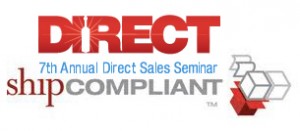 Last Thursday, ShipCompliant held their 7th annual direct sales seminar. This conference served as an opportunity for anyone interested in the business of selling wine direct to consumers to learn how to seize and expand upon this important sales channel. Consumer direct sales of wine have grown considerably over the past few years, aided by loosened regulations, and more states allowing wineries to bypass the traditional three-tier system. Although total direct-to-consumer sales represent only a small percent of total U.S. wine sales, the room for expansion is clearly evident.
Last Thursday, ShipCompliant held their 7th annual direct sales seminar. This conference served as an opportunity for anyone interested in the business of selling wine direct to consumers to learn how to seize and expand upon this important sales channel. Consumer direct sales of wine have grown considerably over the past few years, aided by loosened regulations, and more states allowing wineries to bypass the traditional three-tier system. Although total direct-to-consumer sales represent only a small percent of total U.S. wine sales, the room for expansion is clearly evident.
Sasha Strauss of Innovation Protocol kicked off the event with an animated and inspiring keynote speech. In it, he encouraged marketers and wineries to think first and foremost about the customer – specifically to address and cultivate the experience and emotion that customers attribute to wine. With 7,500 wineries across the states, I think he brought hit upon an especially important point. It’s not enough to simply score well, or get a nice review in the Spectator anymore. As wine consumption increases, and more options become available, wineries must focus on the feeling and experience that accompanies their brand.
By the numbers
- DtC shipments represent only 1% of total wine production
- As compared to other markets measured by Nielsen, the wine market is expanding at a huge rate
- Chardonnay, Pinot and Cabernet account for 58% of DtC sales, but demand for all varietals is increasing across the board
- The Midwest and Southeast are ordering more wine direct
- 85% of DtC shipments originate from CA with Napa leading the way with an average price/bottle of $55.31
- Direct-to-consumer shipments increased 11.5% over the past 12 months
What does all this mean for wine retailers? I think the next five years will bring dramatic increases in direct shipments,. Brands must foster loyalty in their customers, build their web presence, and work closer with online promoters. The creation of the ShipCompliant marketplace allows third-party marketers to sell and promote wine, which opens the door for a new layer of affiliate type marketing surrounding the vertical. As other industries shift their focus to eCommerce, traditional retail chains have seen a shift where consumers want to find their favorite clothing not from Nordstroms, but the niche-specific site like Karmaloop instead.
Measuring marketing performance
One of the more interesting breakout sessions focused on how to measure marketing efforts. Ed Thralls and April Damron explained how the new landscape of direct sales efforts can be measured with free tools like Google Analytics, and smarter tactics like split testing email marketing. Personally, I think this is one of the more important areas that wine marketers need to focus on. As online sales of wine increase, and more diverse channels drive them – from social sites, to bloggers, and third-party marketplaces – measuring and understanding sales performance becomes more important than ever. Especially considering that consumer direct sales bring higher profit margins for wineries.
I think the basic takeaway from the conference for me was that wineries need to open their eyes to the possibilities, think creatively, and expand their online reach into online communities and branding initiatives. With national and local policies loosening, and more people consuming wine, the ship has set sail and will likely be exploring new and profitable territory. Is your winery on board?


















